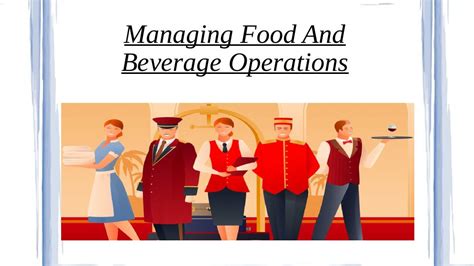The Complete Recipe for Managing Successful Food and Beverage Operations
Managing a food and beverage (F&B) operation is a multifaceted challenge, requiring a blend of culinary expertise, business acumen, and exceptional people skills. This comprehensive guide provides a recipe for success, outlining key ingredients and steps to ensure smooth operations, satisfied customers, and a thriving business.
I. Planning & Strategy: The Foundation of Your Recipe
Before you even think about flipping a pancake, a solid business plan is crucial. This forms the foundation of your F&B operation, guiding all future decisions.
- Market Research: Thoroughly understand your target audience, their preferences, and the competitive landscape. What are their dietary needs and desires? What are the pricing points that work in your area? Identifying this niche is essential for menu development and marketing efforts.
- Concept Development: Define your unique selling proposition (USP). What makes your F&B operation stand out? Are you focusing on a specific cuisine, ambiance, or service style? A strong concept will attract and retain customers.
- Menu Engineering: Create a menu that balances profitability, customer appeal, and operational efficiency. Analyze the cost of each item versus its selling price and customer demand. Consider offering a range of price points to cater to various budgets.
- Financial Projections: Develop realistic financial projections, including start-up costs, operating expenses, revenue forecasts, and profit margins. Secure funding if necessary, and establish a clear budget for your operations.
II. Operations Management: The Cooking Process
Efficient operations are the heart of any successful F&B business. This section focuses on the day-to-day running of your establishment.
- Inventory Management: Implement a robust inventory control system to minimize food waste, manage costs, and ensure sufficient supplies. Use technology like inventory management software to streamline this process.
- Staffing & Training: Hire skilled and passionate staff, and provide comprehensive training on food preparation, customer service, and hygiene standards. Regular training sessions are vital to maintain high service quality and operational efficiency.
- Supply Chain Management: Build strong relationships with reliable suppliers to ensure a consistent supply of high-quality ingredients. Negotiate favorable pricing and payment terms.
- Quality Control: Implement rigorous quality control measures to ensure consistently high standards in food preparation, presentation, and service. Regular checks and taste tests are crucial to maintain consistency.
- Hygiene & Safety: Prioritize hygiene and safety to prevent foodborne illnesses and maintain a clean and safe working environment. Adhere strictly to all relevant health and safety regulations.
III. Customer Service & Marketing: The Garnish
Exceptional customer service and effective marketing are essential for building a loyal customer base and driving sales.
- Customer Experience: Focus on creating a positive and memorable customer experience. Train staff to be friendly, attentive, and efficient. Address customer concerns promptly and professionally.
- Marketing Strategy: Develop a comprehensive marketing strategy that includes online and offline channels. Utilize social media, local advertising, and public relations to reach your target audience.
- Brand Building: Cultivate a strong brand identity that reflects your unique concept and values. Consistency in your messaging, branding, and customer service is key to building brand recognition.
- Feedback Mechanisms: Actively solicit customer feedback and use it to continuously improve your offerings and operations. Utilize surveys, online reviews, and direct customer interactions to gather feedback.
IV. Technology & Innovation: The Secret Ingredient
Leveraging technology can significantly enhance efficiency and customer experience.
- Point of Sale (POS) Systems: Implement a robust POS system to manage orders, payments, and inventory. This streamlines operations and improves accuracy.
- Online Ordering & Delivery: Offer online ordering and delivery options to cater to the growing demand for convenience. Integrate your online platforms with your POS system for seamless order management.
- Customer Relationship Management (CRM): Utilize a CRM system to manage customer data and personalize marketing efforts. This helps to build stronger customer relationships.
By following this comprehensive recipe, you'll be well on your way to building a successful and thriving food and beverage operation. Remember that consistent hard work, attention to detail, and a passion for your craft are the secret ingredients that will make your business truly flourish.
